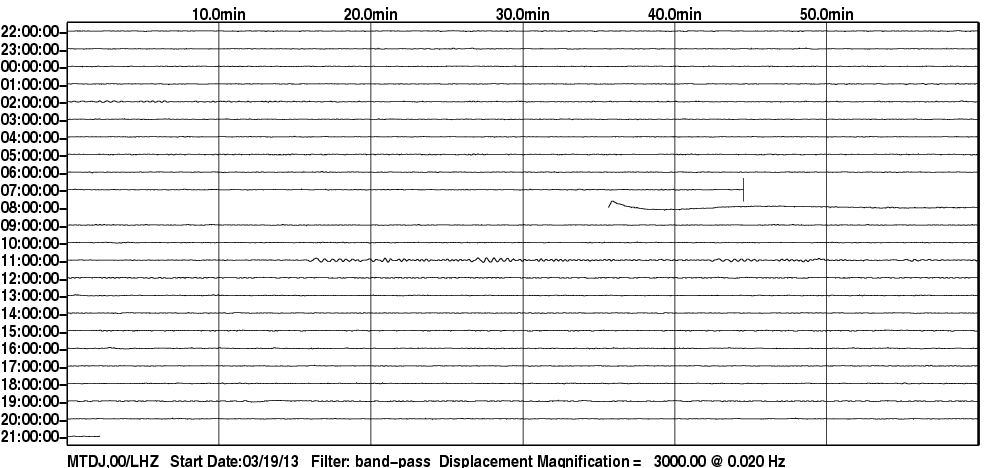Seismic Network Operations
CU MTDJ
Mount Denham, Jamaica
CU MTDJ commences operations on: 2007,342

| Host: | Mininstry of Local Government and Environment |
|---|---|
| Latitude: | 18.226 |
| Longitude: | -77.535 |
| Elevation: | 925 |
| Datalogger: | Q330 |
| Broadband: | STS-2 |
| Accelerometer: | FBA |
| Telemetry Status at the NEIC: |
|
| Location Code | Channel Code | Instrument | Flags | Sample Rate | Dip | Azimuth | Depth |
|---|---|---|---|---|---|---|---|
| 00 | LHZ | STS-2 | CG | 1.00 | -90.00 | 0.00 | 0.00 |
| 00 | LH2 | STS-2 | CG | 1.00 | 0.00 | 90.00 | 0.00 |
| 00 | LH1 | STS-2 | CG | 1.00 | 0.00 | 0.00 | 0.00 |
| 00 | BHZ | STS-2 | CG | 40.00 | -90.00 | 0.00 | 0.00 |
| 00 | BH2 | STS-2 | CG | 40.00 | 0.00 | 90.00 | 0.00 |
| 00 | BH1 | STS-2 | CG | 40.00 | 0.00 | 0.00 | 0.00 |
| 20 | LN2 | FBA | CG | 1.00 | 0.00 | 90.00 | 0.00 |
| 20 | LN1 | FBA | CG | 1.00 | 0.00 | 0.00 | 0.00 |
| 20 | HNZ | FBA | TG | 100.00 | -90.00 | 0.00 | 0.00 |
| 20 | HN2 | FBA | TG | 100.00 | 0.00 | 90.00 | 0.00 |
| 20 | HN1 | FBA | TG | 100.00 | 0.00 | 0.00 | 0.00 |
| 20 | LNZ | FBA | CG | 1.00 | -90.00 | 0.00 | 0.00 |

00 BH2 Monthly PDF

00 BHZ Monthly PDF

00 LH1 Monthly PDF

00 LH2 Monthly PDF

00 LHZ Monthly PDF




Availability, Since 1972

Availability, 2 Month

As part of the annual calibration process, the USGS runs a sequence that includes a random, a step, and several sine wave calibrations. The USGS analyzes the random binary calibration signal in order to estimate the instrument response. The figures below show the results from the analysis of the most recent processed calibration at the station.
We use an iterative three-step method to estimate instrument response parameters (poles, zeros, sensitivity and gain) and their associated errors using random calibration signals. First, we solve a coarse non-linear inverse problem using a least squares grid search to yield a first approximation to the solution. This approach reduces the likelihood of poorly estimated parameters (a local-minimum solution) caused by noise in the calibration records and enhances algorithm convergence. Second, we iteratively solve a non-linear parameter estimation problem to obtain the least squares best-fit Laplace pole/zero/gain model. Third, by applying the central limit theorem we estimate the errors in this pole/zero model by solving the inverse problem at each frequency in a 2/3rds-octave band centered at each best-fit pole/zero frequency. This procedure yields error estimates of the 99% confidence interval.


| Loc | Chan | Cal Date | Epoch-Span | Grade | Amp Nominal Error (dB) | Amp Best Fit Error (dB) | Phase Nominal Error (degree) | Phase Best Fit Error (degree) | Sensor | Cal Type |
|---|---|---|---|---|---|---|---|---|---|---|
| 00 | BHZ | 2011:105 | 2010:041 to No Ending Ti | A | 0.016813 | 0.01515 | 0.1279 | 0.11491 | STS-2-SG | Random |
-
13-Dec-2012Batteries replaced.


